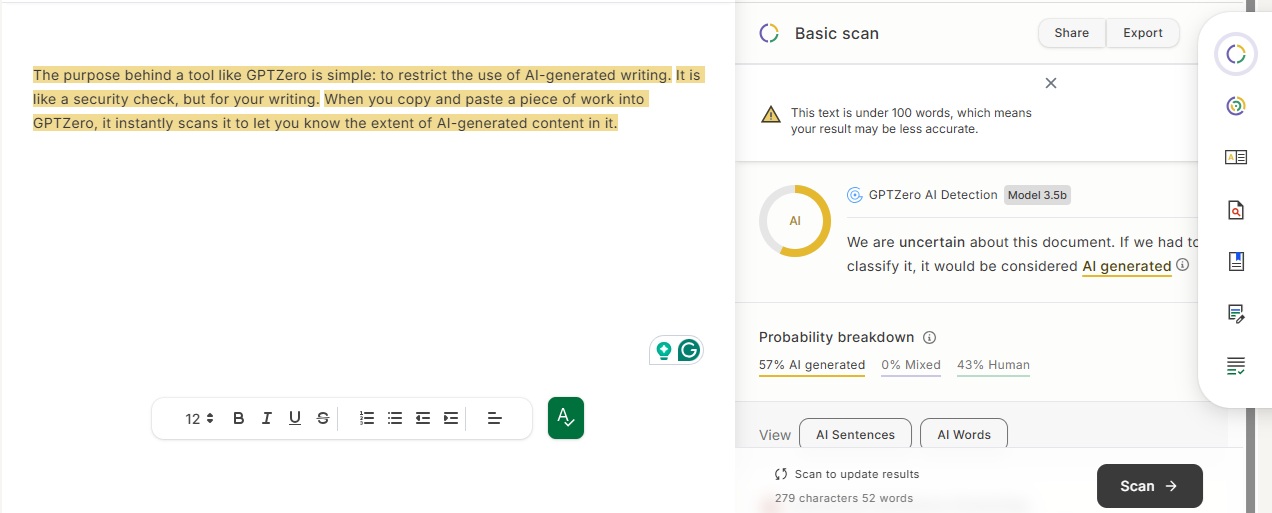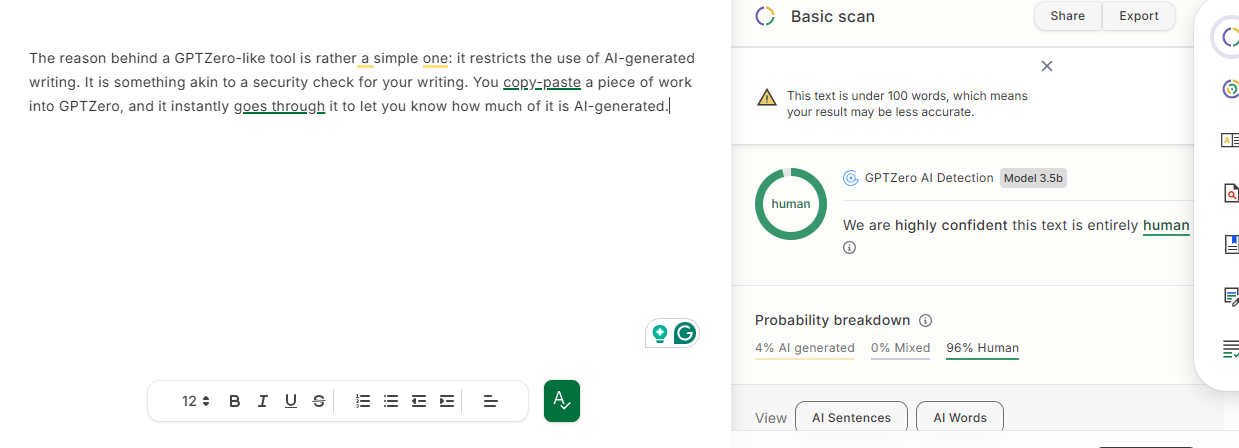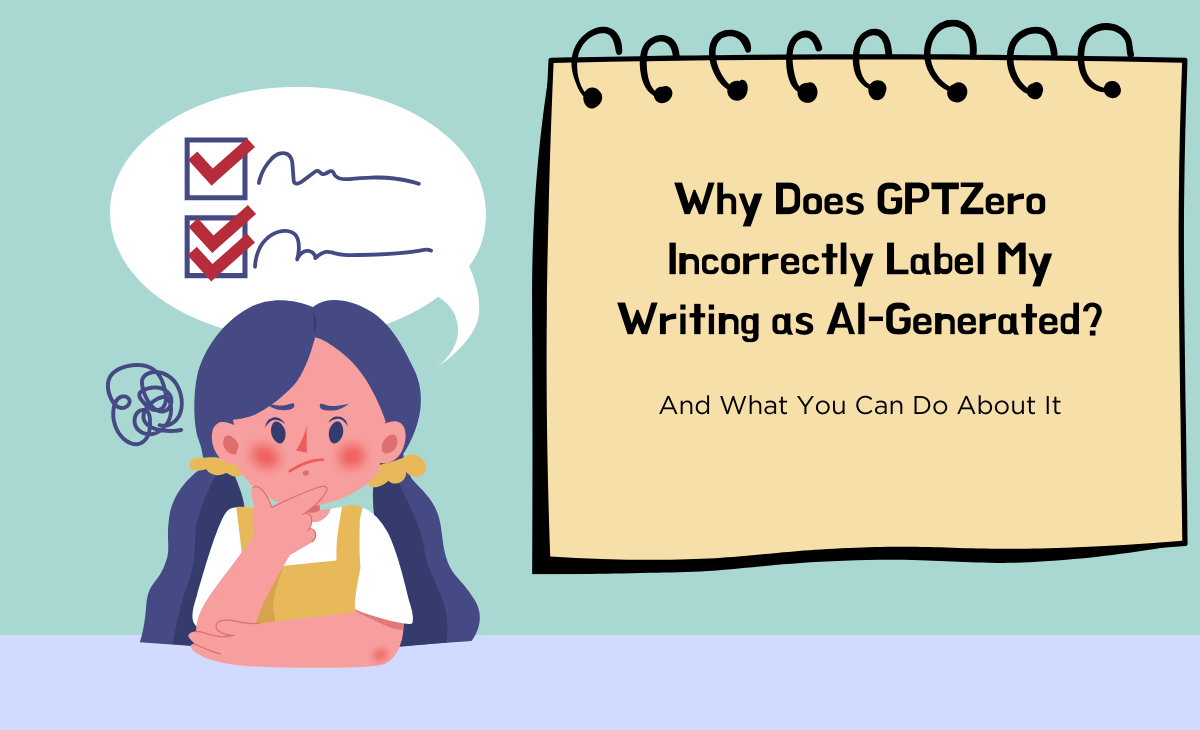As a writer, whether for marketing copy or a research paper, changes can be frustrating. It causes anxiety and makes you feel like all your hard work was in vain. But what’s more frustrating is having to change your work because a detector like GPTZero doesn’t approve of it.
The incorrect labeling of hours of effort as AI-generated content can be heartbreaking, especially if you are on a deadline. You keep asking yourself and the internet why GPTZero incorrectly labels my writing as AI-generated. It leads to a lot of confusion and mostly stress to meet the deadline and yet maintain creative integrity.
Ideally, it is not supposed to be this way, as an AI content detector is expected to flag AI-generated content only. Its purpose is to do a quick security check rather than be a strict vigilante of every phrase and word used. So, how did the dynamics change? Read along to find out.
What Is GPTZero, and How Does It Work?
Currently, GPTZero is one of the leading AI detectors in the market. It is popular for being able to distinguish between human-written and AI-generated text and has a dominating presence in marketing, academic, editorial, and journalistic spaces. If we want to figure out the reason for its malfunctioning, we must understand how it was ideally designed to function.
The purpose behind a tool like GPTZero is simple: to restrict the use of AI-generated writing. It is like a security check, but for your writing. When you copy and paste a piece of work into GPTZero, it instantly scans it to let you know the extent of AI-generated content in it.
You can call it a scanner like the ones they have in the airport to scan for dangerous objects. But the only difference here is that the scanner in our airports scans for actual objects, whereas GPTZero relies on patterns and subtexts.
It is known to work based on two key metrics, namely, perplexity and burstiness. This is where all the magic and apparent confusion happen, and it ultimately leads to GPTZero incorrectly labeling your writing.
To begin with, a tool like GPTZero doesn't know the difference between what’s AI and what's a human. It mostly relies on the commonly used phrases to help it sail through. This is how it works:
Perplexity: Measuring Predictability
Imagine you are out for dinner with a friend of twenty years and with a friend you have met a few months ago. You will be well aware of how your long-term friend eats or what they are going to order next, whereas you might be a bit of a stretch with your new friend. The reason is simple: years of being observant helped you know your friend’s preferences.
It is the same with perplexity when it comes to measuring the predictability of a sentence or text. The moment the detector triggers, if you are using the same phrases or words, it is bound to consider it as an AI-generated piece.
Perplexity is the logic that human-written content is complex and unpredictable with its diverse vocabulary, sentence structures, or nuanced phrasing. It's like your new friend from the restaurant. Whereas AI-generated content sounds like someone who has memorized a script—polished but painfully predictable.
Quick Recap: The lower the perplexity, the more likely the detector thinks it's AI-generated.
🎉 Fun Activity: Go to ChatGPT or Google and type “I drink, complete the sentence.” You will find that the initial response from both tools will either be coffee, water, or some other common beverage.
🔉It is never going to be something complex like “I drink to forget the pain of life,” that’s the job of a human writing something. This is another way to understand how perplexity works.
Burstiness: Measuring Sentence Variety
Sometimes reading AI-generated content feels like working with an instruction manual. Not only does it lack an effort to form a connection with the readers, but it also lacks any sort of visual imagery. That’s how a detector like ZeroGPT places its bet with AI-generated writing.
It relies on the irregular pattern usually found in content written by a human to determine its origin. We always tend to mix our sentences and swing between formal, informal, short, and wordy ones.
But with AI, it's different. The sentences are all short and simple or long and overly formal, and GPTZero looks for a trope like this to establish its nature. So, if you are overtly formal or prefer writing with minimalist undertones, you might just be flagged as AI.
Why GPTZero Might Be Wrong
Perplexity and burstiness are unreliable because they tend to tag every formal and simple text as AI. The irony here is that sometimes being perfect with the grammar and sentence and being concise can surely make you look like a bot. The reason for its lack can be understood easily if you consider the following points:
You Write Too Precisely
AI is known for its perfect and robotic tone that is rigid and way too formal. But what happens when you have to write a paper or discuss the technicalities of a software? Or when you try to sound as precise as possible? That’s when GPTZero starts faltering to register the right input.
As the rigid pattern found in formal or technical writing is quite similar to the AI writing tools, GPTZero confuses your precision with machine-generated content.
Quick Note: I asked GPTZero to scan one of the paragraphs from this blog itself, and this is what it had to say.

Analyzing what happened here will help you understand the concept of false positives in AI content detectors and the issues related to precise writing.
✅ My paragraph is grammatically correct, logically organized, and uses clean transitions, one of the key features of AI-generated writing.
✅ There is a neutral tone that doesn’t try to form a connection with the users, another trait mostly found in AI-generated writing.
✅ Phrases like “the purpose is simple” or “it instantly scans” are common in AI’s writing. So, even though the paragraph was written by me, ZeroGPT flagged it because the expressions closely resemble the kind of language AI tools are trained to use.
Low Perplexity
If you have noticed in this blog, I have talked about an example of eating out with a friend. AI-generated writing doesn’t use a surprise like this to put its point across. It will only talk to the point or use examples that are too cliché or biased.
Now, the moment you start being technical or precise, you run into trouble. In journalism, UX copywriting, and formal documents, you can’t afford to use heightened examples or overly emotional language. That’s when you are bound to face ZeroGPT’s wrath.
You Use Popular Phrases
We don’t use phrases like "Harness the power of" or “scalable solution” anymore. Not because we can't; it's because we don't like reading these overused phrases, and make the narrative like any other blog.
So, what if you have to present a report that needs to be strictly formal, or you are a SaaS company trying to sell its product? You are bound to rely on these phrases as they are handy and easily understandable.
But here’s the catch, ZeroGPT doesn’t know the difference between ChatGPT and your attempt to sell your product or prove a point. All it knows is to identify these phrases and flag them as a caution.
It Was Trained on AI-Generated Text
A model like GPTZero doesn’t know intent or tone. What it does understand is pattern recognition. It was trained on large volumes of AI-generated outputs and knows how to pick up texts that look like those outputs. That means if your human writing happens to resemble any of those AI-generated samples, you are bound to be restricted by ZeroGPT.
Quick Fact: To put it in simpler terms, sometimes your writing gets flagged because it's not that you used AI, but it fits the statistical mold of what it assumes to be AI.
What to Do If GPTZero Labels Your Human Work as AI
Identifying the problem with ZeroGPT is only half the battle. Now comes the harder part: fixing it. Whether you are a student, researcher, marketer, or content writer, getting falsely accused of using AI is not only a question of your credibility but can take away your self-confidence, too. It can even compel you to keep doing the same thing for a better result and wreck your entire creative process. So, you need to break out of the cage with tried and tested ways:
Run It Through Multiple Detectors
Sometimes what GPTZero flags as AI might pass through other detectors just fine. As all these tools are trained on different algorithms, datasets, and parameters, getting a second or third opinion is always going to help you get a better picture. Moreover, if two or more detectors say it's written, you will also feel confident about your work.
Add a Personal Touch
Adding a personal touch is a great way to bypass any detectors. Adding examples that are unique to your experience, even if it's a sentence, can change the detector's verdict in an instant. Moreover, emotional connection and sensory imagery are not something AI is good at. Imagine writing something like “Using our tool will help you find that quiet corner of your own mind.”
Rephrase Robotic Phrasing
Understanding and identifying the most common words and phrases in AI-generated content is another easy way to solve this problem. If you are someone who has to mostly adhere to the formal tone in your writing, you are most likely to get flagged.
But you can still write the perfect piece and not rely on phrases like “profound impact,” “drive insightful data-driven decisions,” and so on. These are often red flags for detectors. Instead, try to reframe ideas in your own voice and give them a much-needed personal touch.
Use a Humanizing Tool (Like Humanize AI 😉)
A tool like Humanize AI is designed to help you with a recurring problem like this one. No one has the time to scrutinize each and every part of their blog or paper once a detector flags it. It is time-consuming, frustrating, and feels like a never-ending task.
That's why Humanize AI can help rewrite your original work just enough to pass AI detectors and without losing your original voice. No one should be penalized for being able to write in a refined tone or use the phrases that everyone’s familiar with.
💡 Important: The goal is not to trick the system. It’s to ensure your genuinely human work doesn’t get mistaken for a machine’s.
In the last example, you saw how ZeroGPT flagged a paragraph from this blog itself as AI-generated content. That paragraph was written by me: a human with deliberate thought, structure, and clarity. But as it was too formal in nature, its credibility was questioned.
However, when I ran the same paragraph through Humanize AI without altering the core meaning, just refining the tone and phrasing, the result was completely different.


🚨This simple test proves how even the most thoughtfully written human content can be misjudged by a popular tool like ZeroGPT. So, a tool like Humanize AI can be a friend that helps maintain your credibility without losing your voice.
Not Everything Polished Is AI
The rise of AI detectors like GPTZero was meant to protect the academic integrity of the users and even test the brand's authenticity. But it has now reached a point where the lines between skilled human writing and repetitive AI tones have started to blur.
So, relying on careful edits or adding a personal tone after a thorough check, or relying on a tool like Humanize AI for ease of access, is now a necessity. As it is the only way to not only pass the detectors, but you can also make sure your human voice stays heard and validated.

